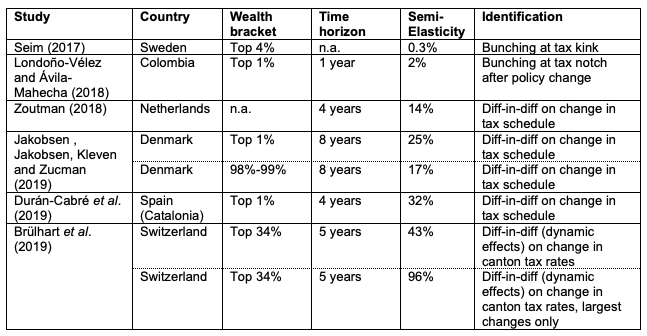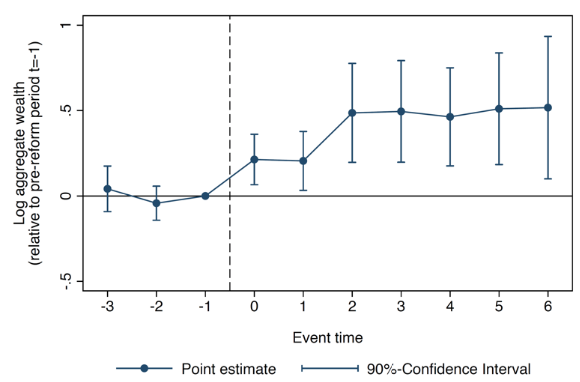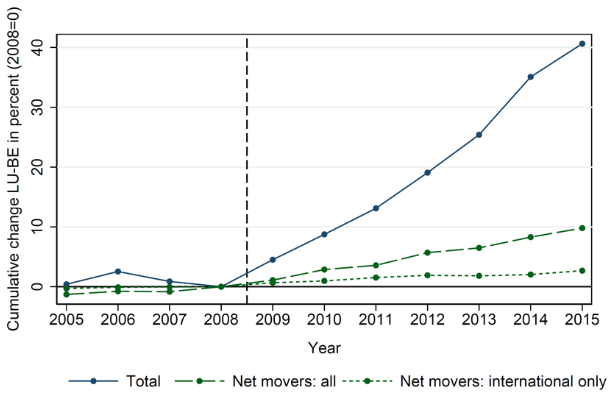Rising capital shares of income and associated increases in inequality observed in many developed nations have spurred new interest in the taxation of wealth. Piketty et al. (2013) have proposed the adoption of an ‘ideal’ combination of taxes on capital, covering annual net worth in addition to capital income and bequests. Saez and Zucman (2019b) advocate the introduction of a wealth tax in the US.
Wealth taxes have also regained popularity in policy circles. US presidential candidates Elizabeth Warren and Bernie Sanders both advocate the introduction of a federal wealth tax. Germany’s Social Democrats have this year adopted the reintroduction of the wealth tax as one of their central policy objectives. President Macron’s decision to replace the French wealth tax by a property tax in 2017 was a major trigger for the ‘gilets jaunes’ protests.
The elasticity of the wealth tax base
Arguments for and against wealth taxes invariably turn on behavioural responses – academic speak for a notion described much more evocatively by others through the ages, from Jean-Baptiste Colbert’s “geese hissing”, to Ayn Rand’s “Atlas shrugging” and Denis Healy’s “pips squeaking”. As a first approximation, the stronger the behavioural responses to a tax, the greater its likely distortionary effects. The tax will also be ‘leakier’, and thus raise less revenue. The elasticity of the wealth tax base is therefore a centrally important policy parameter.
While taxpayer reactions to more common forms of taxation have been studied in considerable depth, behavioural responses to wealth taxes have only recently come into the focus of academic research.1 The comparative neglect of wealth taxes was likely due to their waning importance. Only three OECD nations still levy a wealth tax that covers real estate as well as financial wealth: Norway, Spain, and Switzerland. The withering of the wealth tax deprived researchers both of a motive and of empirical settings for investigating effects of wealth taxes.
Resurging policy interest in wealth taxation, however, has spurred a wave of empirical work on the topic. Researchers have exploited individual-level data in countries that either still levy wealth taxes or have abolished them not too long ago. The main object of those studies is an estimate of the semi-elasticity of taxable wealth with respect to a one percentage-point change in the wealth tax.
Saez and Zucman (2019a) have read this literature as implying a representative semi-elasticity of 8%, which they employ for scoring Senator Warren’s wealth tax proposal. We summarise the main published elasticity estimates in Table 1.
Table 1 Estimates of the semi-elasticity of reported wealth relative to a 1 percentage-point increase in the wealth tax
Researchers have followed two empirical approaches. One approach is to analyse bunching of reported wealth at discontinuities in tax schedules (Seim 2017, Londoño-Vélez and Ávila-Mahecha 2019). This approach yields small elasticity estimates but likely underestimates behavioural responses, since changes in wealth depend to an important extent on asset prices that are uncertain and exogenously determined. Other researchers have therefore used difference-in-difference analysis of changes in wealth tax schedules, comparing taxpayers who are affected differently by these changes for reasons that are arguably unrelated to their subsequent responses (Zoutman 2018, Jakobsen et al. 2019, Durán-Cabré et al. 2019). These studies find responses that are an order of magnitude larger than the bunching-based analyses, with semi-elasticities ranging from 14% to 32%.
Elastic wealth in Switzerland
The main current user of wealth taxes, and therefore in some respects the most propitious laboratory for studying their effects, is Switzerland. Swiss wealth taxes account for 3.6% of tax revenue, by far the highest level in the OECD. Switzerland is different also because its wealth tax schedules have very low exemption thresholds in international comparison, and because wealth taxes are raised at the cantonal and municipal level, with no federal wealth tax.
This leads to sizeable intra-national variation across jurisdictions and over time. In a recent study (Brülhart et al. 2019), we study taxable wealth by canton over the period 2003-2015. Since this was a period of multiple canton-level tax reforms, we can track aggregate responses of wealth holdings to rich longitudinal variation in wealth tax levels.
We find that reported wealth holdings in Switzerland are very responsive to wealth taxation. Figure 1 shows how log taxable wealth in a canton evolves in response to a drop in the wealth tax rate. According to our baseline estimate, a 1 percentage point drop in the top wealth tax rate raises reported wealth by 43%. This estimate is identified by all tax changes in the data, many of which are small. When we focus on the largest canton-level tax reforms, we find even larger semi-elasticities of close to 100%.
Figure 1 Cumulative response of taxable wealth to a decrease in the wealth tax
Source: Brülhart et al. (2019).
Notes: Distributed-lag cumulative effects estimated through a first-differences panel model on canton-year data. Effects can be interpreted as the percentage response of aggregate taxable wealth to a 1 percentage point reduction in the canton wealth tax rate.
Our finding of strong responses is robust to variations of the empirical model and appears fairly constant throughout the wealth distribution. However, even the largest observed responses do not seem to have implied Laffer revenue effects: raising wealth tax rates still increase revenues.
The richness of the Swiss institutional setting allows us moreover to dissect the aggregate responses. For that purpose, we analyse individual-level tax records from two cantons: Lucerne and Bern. We exploit the fact that Lucerne cut its wealth tax by half in 2009 whereas Bern only adopted a modest reform. The difference between the two cantons’ policies can be considered quasi-random, as it hinged on a marginal decision against a larger reform in Bern made possible by a direct-democratic instrument that exists in Bern but not in Lucerne.
Figure 2 shows cumulative wealth growth in Lucerne relative to Bern before and after the tax cut of 2009. While there is no pre-trend prior to the reform, wealth growth in Lucerne clearly exceeded wealth growth in Berne after Lucerne’s tax cut. By 2015, cumulative wealth growth in Lucerne exceeded wealth growth in Bern by 40%. Figure 2 also shows that nearly a quarter of this excess wealth growth is accounted for by net-inmovers into Lucerne, and about a quarter of this moving margin is due to international moves.
Figure 2 Cumulative response of taxable wealth to a decrease in the wealth tax
Source: Brülhart et al. (2019).
Notes: The graph shows cumulative differential changes in wealth of Lucerne relative to Bern, scaled to differential wealth in 2008. It also shows the contributions to the total effect by net intra-national and international taxpayer moves, in the year of moving.
Considering the size of Lucerne – smaller in both area and population than Luxembourg or any of the US states – it is perhaps striking that only a quarter of the tax-base response is attributable to mobility, with most of the increase in the tax base accounted for by responses of already resident taxpayers.
In further analyses, we decompose the remainder of the aggregate response as follows: up to 6% of the response can be attributed to increased savings (including a mechanical effect of lower wealth taxation), some 20% can be attributed to capitalisation into housing prices, and some 50% can be attributed to changes in taxable financial assets of immobile taxpayers.
We have reason to believe that much if not all of the response from increased declared financial assets by non-movers is linked to avoidance and evasion behaviour. Financial wealth in Switzerland is self-reported, with banking secrecy vis-à-vis domestic tax authorities alive and well. When we analyse bunching at tax discontinuities, we also find stronger responses in Switzerland than those reported elsewhere. This is consistent with more prevalent evasion behaviour.
Different settings, different elasticities
Our research suggests that wealth taxes are leakier in Switzerland than elsewhere, for two plausible reasons. First, Swiss cantons are small. This facilitates taxpayer mobility. We find that some 25% of the aggregate response to changed wealth taxation is due to taxpayer mobility. Another 20% of the response is due to capitalisation into housing prices, an indirect effect of mobility. Considering that a quarter of the mobility effect is international, we can conclude that some 34% of the aggregate response are due to intra-national mobility.
Second, tax enforcement in Switzerland is comparatively lax, especially as financial wealth is self-reported. About 50% of the aggregate response are due to changes in reported financial assets of non-movers. Complementary evidence does not suggest that this effect can be attributed to changed savings or earnings.
On the face of it, up to 85% of the large responses of taxable wealth observed in Swiss cantons could therefore be the result of the cantons’ small size and of lax enforcement. If we reduce our estimated responses by 85%, we obtain elasticities that are if anything lower than those found elsewhere (see Table 1). As a consequence, Saez and Zucman’s (2019a) assumed semi-elasticity of 8% for scoring a US wealth tax turns out to be consistent with our estimates – provided evasion opportunities in the US will indeed be as limited as they assume.
We do not know, however, whether the avoidance options available in Switzerland mitigate ‘real’ responses through savings and labour supply. Avoidance could to some extent act as a substitute for real responses. Considerable uncertainty also remains about potential responses to wealth taxes of up to 6%, as proposed in the US. The top wealth tax rate in Switzerland is 1%, and the halving of wealth taxes in Lucerne that informs our decomposition estimates implied a drop in the tax rate of 0.28 percentage points.
Our research shows that flaws in the design of wealth taxation can lead to large avoidance responses. Enforcement is key.
References
Brülhart, M, J Gruber, M Krapf, and K Schmidheiny (2019), “Behavioral Responses to Wealth Taxes: Evidence from Switzerland”, CEPR discussion paper 14054.
Durán-Cabré, J M, A Esteller-Moré, and M Mas-Montserrat (2019), “Behavioral Responses to the (Re)introduction of Wealth Taxes. Evidence from Spain”, Institut d’Economia de Barcelona working paper 2019/04.
Jakobsen, K, K Jakobsen, H Kleven, and G Zucman (2019), “Wealth Taxation and Wealth Accumulation: Theory and Evidence from Denmark”, Quarterly Journal of Economics, forthcoming.
Londoño-Vélez, J and J Ávila-Mahecha (2019), “Can Wealth Taxation Work in Developing Countries? Quasi-Experimental Evidence from Colombia”, Mimeo, UC Berkeley.
Piketty, T, E Saez, and G Zucman (2013), “Rethinking Capital and Wealth Taxation”, Mimeo, Paris School of Economics.
Saez, E, J Slemrod, and S H Giertz (2012), “The Elasticity of Taxable Income with Respect to Marginal Tax Rates: A Critical Review”, Journal of Economic Literature, 50(1): 3–50.
Saez, E and G Zucman (2019a), “How Would a Progressive Wealth Tax Work? Evidence from the Economics Literature”, Mimeo, UC Berkeley.
Saez, E and G Zucman (2019b), “Progressive Wealth Taxation”, Brookings Papers on Economic Activity, forthcoming.
Seim, D (2017) “Behavioral Responses to Wealth Taxes: Evidence from Sweden”, American Economic Journal: Economic Policy 9(4): 395–421.
Zoutman, F T (2018), “The Elasticity of Taxable Wealth: Evidence from the Netherlands”, Mimeo, Norwegian School of Economics.
Endnotes
[1] For a survey of research on behavioural responses to income taxation, see Saez et al. (2012).










